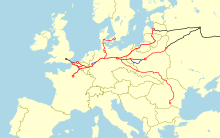Nord Express
- Machine translation, like DeepL or Google Translate, is a useful starting point for translations, but translators must revise errors as necessary and confirm that the translation is accurate, rather than simply copy-pasting machine-translated text into the English Wikipedia.
- Consider adding a topic to this template: there are already 377 articles in the main category, and specifying
|topic=will aid in categorization. - Do not translate text that appears unreliable or low-quality. If possible, verify the text with references provided in the foreign-language article.
- You must provide copyright attribution in the edit summary accompanying your translation by providing an interlanguage link to the source of your translation. A model attribution edit summary is
Content in this edit is translated from the existing Dutch Wikipedia article at [[:nl:Nord Express]]; see its history for attribution. - You may also add the template
{{Translated|nl|Nord Express}}to the talk page. - For more guidance, see Wikipedia:Translation.

The Nord Express (Northern Express) was a long-distance international express train which for more than a century connected Paris with first Russia and later Poland, the Baltic states and Scandinavia. In its heyday before the First World War, it was considered the ultimate luxury train in Europe.
Introduced in 1896 by the Compagnie Internationale des Wagons-Lits, which operated sleeping-cars, dining cars and trains deluxe all over Europe, including the Orient Express, it connected Paris and Saint Petersburg. After World War I and the Russian Revolution, the train's route was shortened to Warsaw and Riga instead of Saint Petersburg. And after World War II the "iron curtain" diverted the train's route further to Stockholm and Oslo, until air travel caused the end to this famous train.
Although the Nord Express has received significantly less attention than the Orient Express, it is one of the CIWL's best-known luxury trains and has been featured in a number of artistic works.
History
Background

In 1874, the Belgian civil engineer and railway entrepreneur Georges Nagelmackers founded the Compagnie Internationale des Wagons-Lits (lit. International Sleeping-Car Company, also CIWL). The purpose was to establish a network of luxurious long-distance passenger trains across the European continent inspired by the Pullman night trains of the United States. As one of these train connections, the CIWL wanted to establish a direct cross-continental link between Saint Petersburg and Lisbon to connect with ocean liners to America. However, this concept proved too complex and could not be realized. In turn, two separate connections arose: the Sud Express from Paris to Lisbon and the Nord Express from Paris to Saint Petersburg.[1]
Before World War I

On 9 May 1896, the Nord Express departed for the first time from the French to the Russian capital. This train service enabled people to travel across Europe in what was, by the standards of the time, a very fast and comfortable manner. For the operation of the Nord Express, the CIWL had to close contracts and timetable agreements with fourteen railway administrations, including nine Prussian administrations, as well as the ferry service across the English Channel between Dover and Ostend.
The train left Paris and Ostend (with connection from London) and travelled via Brussels, Cologne, Hanover, Berlin, Königsberg (now Kaliningrad) and Dvinsk (now Daugavpils) to Saint Petersburg. Passengers to and from Russia had to change once in East Prussia at the German/Russian border because Russian railway tracks are of a wider gauge than those in Western Europe. In Paris there was a connecting service to the Sud Express (Southern Express) to Lisbon.
Interwar period

After World War I and the Russian Revolution the train's route was shortened to Warsaw and Riga instead of Saint Petersburg. Riga joined the connection in 1923, with a separate Riga–Moscow line introduced as well.
Post-War Period

After World War II the "iron curtain" divided Europe, and the initially luxury and since 1951 ordinary night train's route was diverted further from Paris via Hamburg and Copenhagen to Stockholm and Oslo.
The emergence of air travel and high-speed rail caused the end to this famous train. In 2007 it was shortened further and such that it ran between Paris and Hamburg, taking 10.5 hours.
In the arts
The Nord Express has received significantly less attention than the Orient Express. Nevertheless, it is one of the CIWL's best-known luxury trains and has been featured in a number of novels and films:
- Georges Simenon's detective novel The Strange Case of Peter the Lett (1931) starts with the arrival of the Nord Express at the Gare du Nord in Paris. It is the first novel to feature Inspector Jules Maigret who would later appear in more than a hundred stories by Simenon and who has become a legendary figure in the annals of detective fiction.
- Vladimir Nabokov describes in the seventh chapter of Speak, Memory how he traveled on the Nord Express from Saint Petersburg to France for a holiday in 1906.
- Alfred Hitchcock's movie Strangers on a Train (1951),[2] was translated to French as "L'inconnu du Nord-Express" (The unknown man in the Nord-Express).
- The animated 20th Century Fox movie, Anastasia (1997) mentioned that the train was traveling from Saint Petersburg to Paris, which was most likely referring to the Nord Express.
- The final conflict of The Silver Skates revolves around gaining passage to Paris on the Nord Express.
References
Citations
Bibliography
- Behrend, George (1959). The History of the Wagons-Lit, 1875-1955. London: Modern Transport Publishing Company. OCLC 4535323.
- Mühl, Albert (1991). Internationale Luxuszüge : Die grossen europäischen Expresszüge durch Deutschland, Österreich und die Schweiz [International Luxury Trains : The great European express trains through Germany, Austria and Switzerland] (in German). Freiburg im Breisgau: Eisenbahn-Kurier Verlag. ISBN 3-88255-673-0.











